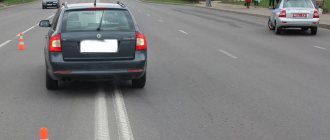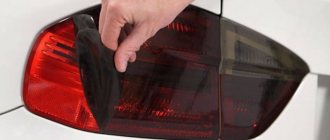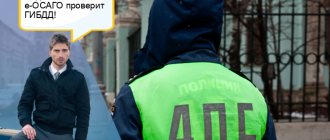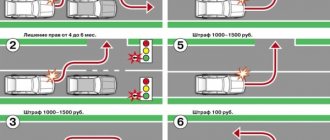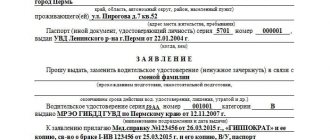Is it possible to return a custom-made product: of proper and improper quality, procedure, return deadlines
consumer properties, seals, factory labels, as well as all documents received from the seller (receipts, warranty card, instruction manual).
Among motorists, beginners or experienced, you can often find drivers who do not understand the intricacies of the question of whether it is possible to drive on tram tracks. In this case, the traffic rules strictly stipulate the options when such maneuvers are allowed, and when such movement is completely excluded. Car owners will need to be aware of all the nuances, since violation of existing regulations may result in a fine.
When is travel possible?
Since tram rails are not part of the roadway, traffic rules (clause 9.6) limit the list of situations when movement on the tracks is allowed.
To travel, the following conditions must be met:
- the direction of movement must be in the same direction;
- all other lanes of the road are occupied;
- the rails are located flush with the road surface;
- The track is on the left side relative to the movement of the machine.
IMPORTANT! Although moving along tram tracks is permitted in some situations, in no case should the car interfere with the tram itself while driving.
Additionally, it is allowed to carry out a number of maneuvers, provided that the car and the tram are in the same direction, as well as the location of the rails on the left side of the main route.
The following actions are allowed:
- turn to the left;
- turn;
- advance.
IMPORTANT! When turning left, the rails should be occupied in the absence of a passing tram. Next, you should turn on the turn signal, let oncoming traffic pass and turn.
It is also allowed to cross the intersection along the tram track. However, if signs 5.15.1 or 5.15.2 are present, movement is impossible.
In what cases is movement prohibited?
Based on the requirements, compliance with which allows movement on tram rails, directly opposite cases can be identified.
It is prohibited to drive a car on paths laid out for public transport if:
- the rails pass to the right of the highway along which the car follows;
- the tracks are not laid at the same level with the road - lower or higher, in this case the rails act as a dividing strip, entry and movement along which is prohibited;
- Next to the track there is a marking in the form of a solid line and signs indicating the direction are placed.
Another important point is whether it is possible to travel along the tracks in the opposite direction relative to the movement of the tram and whether the set of road rules allows passage in the opposite direction. In this case, the answer is obvious - no, moving towards public transport is excluded. Such driving not only creates a traffic jam and prevents the movement of other car owners, but also provokes an emergency situation.
IMPORTANT! Overtaking on a tram track, which involves driving into oncoming traffic, is prohibited.
Oncoming tram lanes may only be crossed if necessary. Medical examination for a driver's license? However, there are a number of exceptions when drivers are allowed to travel in this direction.
This is possible in the following cases:
- repair work on tracks in the same direction, subject to the possibility for workers to travel in oncoming traffic;
- in the event of a global accident when regulating the passage by a traffic police officer.
IMPORTANT! Long driving in the opposite direction is possible only in extreme situations, for example, when transporting a patient. In the future, it will be necessary to provide evidence of this fact.
Moving towards the tram
The movement of vehicles on the oncoming rail track is prohibited.
It is only permissible to move over it, performing U-turn and turning maneuvers. The rules govern the following exceptions:
- Repair work is often carried out at the location of the strip. Road services organize traffic flow in a detour. This situation allows the traffic police to allow the tram to bypass the obstacle along oncoming rails.
- It happens that an accident occurs near the railway tracks. In order to thoroughly understand the causes of the incident, road workers direct each car to detour into the oncoming lane of trams.
- Sometimes a traffic situation arises in which the driver of a car is transporting a patient with a critical health condition. The person needs emergency medical help and should be hospitalized as soon as possible. The road runs only through oncoming tracks with rails. If there are no other routes for travel, as an exception, trams are allowed to travel in the oncoming lane in compliance with increased safety measures.
Every driver must understand that the last point does not relieve him of responsibility. The need to violate the rules for traveling on rails will have to be proven in court.
Often, even with a favorable court ruling, the violator is punished. Law enforcement officers issue a financial penalty, which the offender must pay.
Administrative responsibility
Strict administrative sanctions are provided for ignoring the rules for traveling on tram tracks. The degree of punishment and the amount of the fine depends on the type of violation.
The amount of recovery or other type of administrative liability may be:
- Driving onto the rails while crossing solid markings - 500 rubles or a warning from the inspector.
- Driving in the opposite direction of the tracks will result in a fine of 5,000 rubles or revocation of your license for six months. Fixing a repeated violation by a traffic inspector will result in the confiscation of the license for 1 year.
- Traveling on a passing track, but interfering with a tram - a fine of 500 rubles.
- Stopping on the rails costs 1,500 rubles, and in large cities (St. Petersburg, Moscow and others) no less than 3,000 rubles.
- Driving onto a track in the opposite direction to avoid obstacles - from 1000 rubles to 1500 rubles.
IMPORTANT! A traffic jam when driving onto oncoming roads is not considered an obstacle, so its presence will not protect you from punishment and the driver will also need to pay a fine in the amount of 1000 to 1500 rubles.
Video about moving along tram tracks
Driving a car along tram routes is permitted according to traffic regulations, but only if a number of requirements are met. The main one is the location of the tram track to the left of the route along which the car follows. But maneuvers if the rails are laid on the right are strictly prohibited. However, the same goes for moving along the tracks towards the tram. For these and other types of violations, administrative sanctions are provided.
Additional Information
The ability to travel along tram tracks in the same direction according to the 2021 traffic regulations is limited to certain conditions. Rails in the same direction are not intended for the movement of trackless vehicles.
A selection for you!
Download forms and sample documents for motorists to a safe place.
Fines
Violation of driving on tram tracks may be punishable by an administrative fine or deprivation of the right to drive vehicles for up to 12 months .
Photo and video recording of violations
- The fine for passing (driving) at an intersection on tram tracks in the same direction under the influence of a “Traffic in Lanes” sign is 500 rubles ;
- Traveling on rails that are not intended for travel (fenced, located above or below the level of the road surface, the tracks have a solid marking line prohibiting crossing) - 500 rubles ;
- Driving onto oncoming tram tracks fine – 5,000 rubles ;
- Repeated departure on the opposite route – 5,000 rubles .
Here you will find information about other fines for traffic violations.
Stop by a traffic police inspector
- Traveling on passing roads through an intersection under the sign “Traffic in lanes” - 500 rubles ;
- Interfering with a tram – 500 rubles ;
- Driving along roads that are not intended for travel (fenced, located above/below the level of the roadway, there is a continuous marking line) - 500 rubles ;
- Partial travel to oncoming tram tracks (detour around obstacles and other situations) – 1,000 – 1,500 rubles ;
- Departure on the opposite – 5,000 rubles ;
- Deliberate travel on the path of the oncoming direction - deprivation of rights from 3 to 6 months ;
- Repeated departure on the opposite – deprivation of rights for up to 12 months .
Don't forget about other violations:
- parking in the wrong place, including on the sidewalk and lawn;
- driving on the sidewalk;
- lack of low beam during daylight hours;
- what you should know about the “No Traffic”, “No Trucks” and “Brick” signs;
- what are the dangers of driving through a red traffic light?
- fines for not wearing a seat belt.
Is it possible to travel on tram tracks? In which cases?
Even professional drivers often have problems related to the ability to move on tram rails.
Many drivers do not know the exact answer to the question whether it is possible to drive on tram tracks in accordance with the traffic rules.
To understand this, you should consider in detail the nuances of movement along tram tracks.
Tram tracks do not belong to a component of the roadway; they are considered a separate element of the road.
When is it allowed and forbidden to travel on tram tracks?
According to traffic regulations, traffic on them is permitted, but only if certain conditions are met:
- The 2021 traffic rules allow traffic on tram tracks in the same direction only if it is not possible to move along the road lanes. But when a car moves on rails, it should not in any way interfere with the movement of the tram.
- In the case when the tram rails are level with the road.
- When the tram tracks are on the left.
- When all lanes are occupied.
Cases when movement on tram tracks is prohibited:
Traveling along tram rails can be used for the following actions:
- turning left;
- moving straight;
- turn.
When driving onto the rails, you should always remember an important rule - the car should not interfere with the movement of the tram.
Entering public transport lanes in the same direction is prohibited if appropriate signs are present.
For example, along the route of a tram road there may be a solid line or the location of “Traffic Lane” and “No Entry” signs.
In this case, you need to follow the instructions of the installed signs and move only along the designated lanes.
If there is a solid line along the tram tracks, this means that you cannot cross it. It marks the edge of the roadway, and even if on one side traffic on tram tracks in the same direction is allowed, you can get a fine for crossing this line.
To separate the adjacent roadway, separate tram tracks are used - this is a structurally separated element of the road.
Separate tram tracks are not intended for the movement of trackless vehicles.
Accidents on tram tracks.
First of all, we note that traffic accidents on tram tracks are fraught for the culprit with the recovery of lost profits through the court of the Transport Administration of your city, because during the registration of an accident, trams cannot move along the route. Usually this is several tens of thousands of rubles, and in large cities the courts go along with the plaintiff, so if you are guilty of an accident , no matter involving a tram or not, try to clear the way for the trams as quickly as possible .
In the event of an accident on tram tracks without the participation of a tram, i.e. between cars, you can quickly record witnesses, draw up an accident diagram, sign it for both participants, take a photo of the accident scene on your phone, and immediately go to the local traffic police to register the accident. Or you can do without the traffic police - using the scheme for registering an accident according to the European protocol.
If a tram was involved in an accident, its driver will be innocent of the accident, unless the tram was leaving the DEPOT at that moment, or was not moving against a prohibiting traffic light. After all, the use of tram tracks by vehicle drivers is initially permitted only if they do not interfere with the movement of trams.
Movement on passing tram tracks
The ability to travel along tram tracks in the same direction according to the 2021 traffic regulations is limited to certain conditions. Rails in the same direction are not intended for the movement of trackless vehicles.
Location of tram tracks when traffic is allowed:
- to the left of the roadway;
- flush with the roadway.
But only in such cases:
- when all other lanes are occupied;
- a detour is in progress;
- making a left turn or a U-turn in accordance with paragraph 8.5 of the traffic rules.
If there are no other restrictions for a left turn or U-turn, and these maneuvers can be performed on any section of the road where there are no restrictions.
Traveling on tram tracks in the opposite direction
It is equally important to consider whether it is allowed to use tram tracks in the opposite direction for traffic. The answer will be unequivocal - it is not allowed.
In accordance with traffic rules, oncoming tram rails are only allowed to be crossed. Cars cannot drive on the paths of passing traffic or on the paths of oncoming traffic.
Such actions can provoke a serious accident, congestion, and interfere with the movement of trams.
But there are exceptions to all rules. There are cases in which you can travel on tram tracks in the opposite direction:
- During repair work on passing lanes. At the same time, traffic police officers organize a detour along oncoming traffic lanes and can use tram rails in the oncoming direction.
- Driving on rails in the opposite direction is possible in the event of a major accident. In such cases, traffic police officers are required to independently regulate traffic flows.
Sometimes a driver has to drive onto the rails of the oncoming direction, having good reasons for this, for example, when he is taking a person to the hospital, and there are no other ways to bypass.
In this case, evidence must be presented during the trial. If the outcome is positive, the violator faces only a monetary administrative penalty.
When is it allowed and when is it prohibited to drive?
Referring to clause 9.6 of the traffic rules, it is allowed to drive along railway tracks by car when all passing lanes of the required road are occupied, and the remaining paths are on the left at the same level of the roadway and run parallel to your lane. Moreover, such a maneuver should not create additional interference with trams. Similar rules apply when passing, turning left, or making a U-turn.
Among other clarifications, clause 8.5 notes cases when the driver is a priori obliged to move on the rails. Here we are talking about turning left and making a U-turn under the same conditions, unless the signs provide for an alternative driving order. On the other hand, you cannot go onto tram tracks that:
- Located on the right side.
- Are located above or below the level of the highway.
- Fenced off by some kind of structures.
- Have prohibiting signs or markings.
- Designed for right turns.
In parallel with the agreed schemes, clause 9.6 of the traffic rules separately states that driving onto the rails in the opposite direction is completely prohibited. But it’s worth understanding the taboos and exceptions on the road in more detail in specific situations.
Driving straight along the tracks
The chance to overcome the railway tracks in the same direction without obstacles, according to the rules of 2021, is limited by strict conditions. In the specified case, rails in the same direction are not considered for use by other types of transport. Their location when traffic is allowed: to the left of the highway or at level with the roadway.
So, in theory, they are not considered a dividing strip. In this case, all other lanes must also be occupied, a detour or maneuver to the left is performed, in accordance with clause 8.5 of the mentioned rules.
When there are no other prohibitions for turning, then changing direction by car can be done on that section of the road where there are no prohibitions. Auxiliary restriction measures are regulated by special markings and additionally installed signs. For example, if a continuous marking line according to clause 1.2 is applied along the rails, then you cannot cross it for subsequent driving.
On opposite paths
Theoretically, moving on the oncoming road and rail in a similar case is also prohibited by the rules. It is permissible to cross it only to turn or, when such exceptions are indicated, where the road surface requires global reconstruction.
So the road patrol deliberately plans a suitable analogue of the direction of traffic in a detour, and traffic police officers take into account the detour of the obstacle through the oncoming lane.
It is extremely important to carefully study the problem of whether it is a priori permissible to use rails in the opposite direction for driving. The most accurate answer will be “unequivocally no.”
According to traffic rules on the roads, oncoming rails are only allowed to be crossed carefully. Cars are not allowed to drive on railway tracks of oncoming traffic. Such arbitrary maneuvers risk causing a serious accident, congestion, and also interfering with the movement of trams.
But even from such strict requirements exceptions can be made. There are rare cases when you can freely follow the rails in the opposite direction: during repair work in areas of passing traffic or in the event of a large-scale accident. In such cases, traffic police officers will be forced to control the flow of cars on their own.
Sometimes the driver is completely forced to drive onto the rails in the opposite direction, having good reasons for this: when he is taking a passenger to the hospital, and other alternative detour routes are excluded. But in such a scenario, it is still necessary to present evidence later during the trial, if it does come to trial. So, if the outcome is positive, the violator faces only material administrative penalties.
U-turn and overtaking
If we evaluate safe maneuvers of a different type, then turning left on the rails is not prohibited. Before implementing such a restructuring scheme on the street, every driver needs to know for sure that this area does not have full markings on each side. Therefore, the intended manipulation can only be carried out at a right angle, otherwise traffic police officers will regard the incident as entering the oncoming lane.
It is also necessary to remember that by default, overtaking is: entering the lane of oncoming traffic or getting ahead of the car in front, as well as a deliberate return to the initially selected lane. From this it becomes clear that overtaking a tram on oncoming tracks is impossible and is prohibited by current traffic regulations.
An adjacent maneuver on rails already in the same direction is also excluded. Although a slowly moving tram can be passed on the left, provided it enters the oncoming lane of the highway.
A similar trick should be performed as follows: turn on the left turn signal of the car, drive into the oncoming lane, pass other public transport on the left side, then turn on the right turn signal again and finally return back. Moreover, do not forget about the prohibition of creating obstacles to other moving cars on your way.
Movement through the intersection of tram tracks
In particularly individual and complicated situations, car owners are allowed to drive over tracks in places that are not properly regulated in the first place. Then the tram and the car move in the same direction to the intersection, while the railway tracks themselves are on the right side of the transport, and the tram is simply forced to travel in a straight line. It turns out that the tram and the car are moving parallel to each other, and the line is to the right of the driver when both decide to turn left.
As a result, the trajectory is on the right, the car is moving strictly in a straight line, and the tram is about to go to the left. This is exactly how the traffic rules on the city highway allow driving on rails when focusing on certain conditions. At the same time, simple left turns and turns are allowed there. But, if a motorist still ends up on the rails, he should not interfere with the further movement of public transport with his confusing route.
Turning on rails and overtaking
Traffic rules allow left turns across public transport lines.
Before turning around, you should check that there is no marking line on either side of the tracks. This action should only be performed at a 90 degree angle.
Otherwise, traffic police officers may regard this as driving into the oncoming lane. Checking your car for theft? For these actions, a fine of 5,000 rubles or withdrawal of rights is provided.
Overtaking on tram lanes is prohibited, even if it is moving on rails in the same direction.
Since this maneuver is associated with entering the oncoming line in any case. At the same time, traffic rules allow you to get ahead of passing traffic when other lanes are busy.
Traffic through an intersection
In certain situations, it is allowed to cross a track at an intersection that is not regulated:
- The tram and the car were moving in the same direction towards the intersection, while the tracks are on the right side of the motorist, and the tram will travel in a straight line.
- The tram and the car are moving parallel in the same direction, the line is on the right side of the driver and both will turn left.
- The line is on the right, the car is moving in a straight line, and the tram is about to turn left.
Thus, traffic rules allow driving on tram tracks if certain conditions are met. Left turns and turns are also allowed.
But when a motorist drives onto the rails, he should not interfere with the movement of public transport.
For non-compliance with the rules of movement on tram tracks, penalties are provided. Penalties will depend on the severity of the violation.
How to challenge a fine and avoid punishment
In practice, it is possible to challenge the entry of a car onto oncoming tram tracks. The challenge procedure is not fundamentally different from that used to cancel any other fines for non-compliance with traffic rules.
If a protocol has been drawn up against the driver for traveling on tram tracks in the opposite direction, you need to study it for the materials indicated by the traffic police officers that prove the guilt of the offender.
Upon receipt of a subpoena, a citizen must immediately familiarize himself with the case and prepare for the court hearing. It is important to analyze all the arguments not in favor of the driver and have arguments and material evidence to prove his innocence.
To familiarize yourself with the case, a petition , and while studying the materials, you can take photographs of them (for example, on a mobile phone). If you don’t have time to resolve your case, it is recommended to contact lawyers who successfully resolve disputes over traffic violations.
When studying the case, special attention should be paid to :
- protocol on administrative offense,
- administrative offense scheme,
- photo and video evidence.
In addition, this violation can be reclassified under Part 3 of Art. 12.15 Code of Administrative Offenses of the Russian Federation - avoiding obstacles. But difficult traffic on the road does not count as obstacles, so the guilty person cannot refer to this particular circumstance.
To challenge guilt and avoid a fine, the driver must appear at the court hearing and state that there was no continuous marking line on the road, or that he did not drive onto oncoming roads and did not cross the marking line. The latter argument will only hold if there is no CCTV footage to prove otherwise.
In addition, you can claim about:
- illegality of drawing up a protocol of an administrative offense,
- irregularities in the scheme,
- an error in the presentation of the circumstances of the case in the protocol,
- the actual situation on the road at the time of the violation,
- calling witnesses to the court hearing who can testify in favor of the driver.
Information: if the evidence presented to the court is sufficient and reliable, the driver can count on the punishment being cancelled, but to guarantee victory in court, it is better to seek help from a specialist.
To avoid paying a very large fine, car drivers should always remember that it is prohibited to travel on tram tracks and try not to use this method to reduce travel time or overtake other cars.



